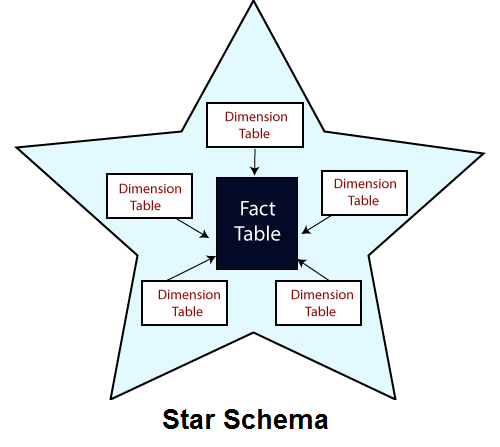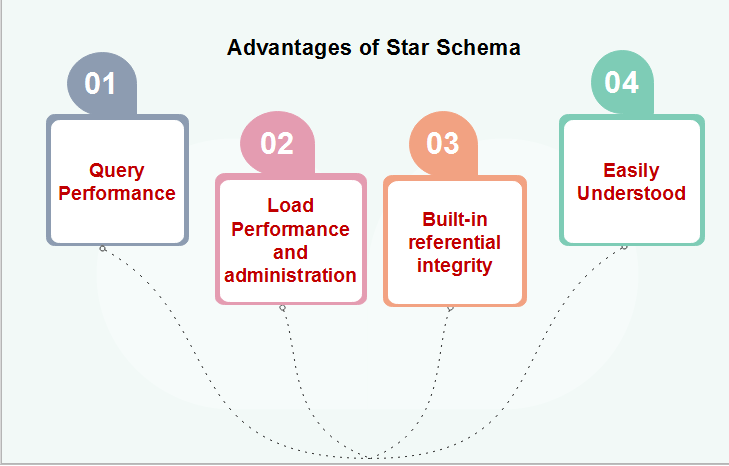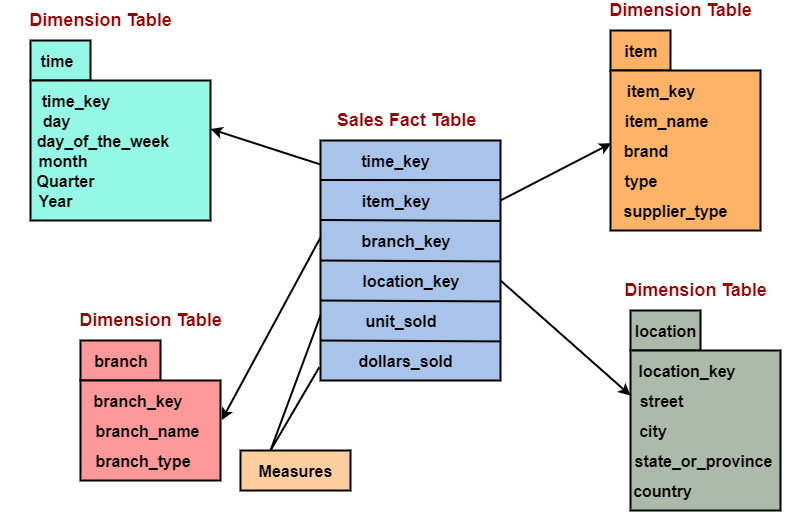Draw a Star Schema Diagram for the Data Warehouse
What is Star Schema?
A star schema is the elementary form of a dimensional model, in which information are organized into facts and dimensions. A fact is an event that is counted or measured, such as a sale or log in. A dimension includes reference information about the fact, such as date, particular, or customer.
A star schema is a relational schema where a relational schema whose design represents a multidimensional data model. The star schema is the explicit data warehouse schema. It is known as star schema considering the entity-relationship diagram of this schemas simulates a star, with points, diverge from a central table. The heart of the schema consists of a large fact table, and the points of the star are the dimension tables.

Fact Tables
A table in a star schema which contains facts and connected to dimensions. A fact table has two types of columns: those that include fact and those that are strange keys to the dimension tabular array. The primary central of the fact tables is generally a composite fundamental that is made up of all of its foreign keys.
A fact table might involve either particular level fact or fact that accept been aggregated (fact tables that include aggregated fact are oft instead called summary tables). A fact table mostly contains facts with the same level of aggregation.
Dimension Tables
A dimension is an architecture usually composed of one or more hierarchies that categorize data. If a dimension has not got hierarchies and levels, it is called a flat dimension or list. The master keys of each of the dimensions table are part of the composite primary keys of the fact table. Dimensional attributes help to define the dimensional value. They are generally descriptive, textual values. Dimensional tables are normally small in size than fact table.
Fact tables store data virtually sales while dimension tables data about the geographic region (markets, cities), clients, products, times, channels.
Characteristics of Star Schema
The star schema is intensely suitable for information warehouse database pattern because of the post-obit features:
- It creates a DE-normalized database that can apace provide query responses.
- It provides a flexible design that can be changed easily or added to throughout the development cycle, and as the database grows.
- It provides a parallel in pattern to how terminate-users typically think of and use the data.
- Information technology reduces the complexity of metadata for both developers and end-users.
Advantages of Star Schema
Star Schemas are piece of cake for end-users and application to understand and navigate. With a well-designed schema, the customer can instantly clarify big, multidimensional information sets.
The main reward of star schemas in a determination-back up surround are:

Query Functioning
A star schema database has a express number of tabular array and clear join paths, the query run faster than they do against OLTP systems. Small single-table queries, oft of a dimension table, are almost instantaneous. Large join queries that contain multiple tables takes only seconds or minutes to run.
In a star schema database design, the dimension is connected only through the primal fact table. When the two-dimension tabular array is used in a query, only one join path, intersecting the fact tables, exist between those two tables. This design characteristic enforces authentic and consequent query results.
Load performance and administration
Structural simplicity also decreases the time required to load large batches of record into a star schema database. Past describing facts and dimensions and separating them into the various tabular array, the impact of a load structure is reduced. Dimension tabular array can be populated once and occasionally refreshed. We can add new facts regularly and selectively past appending records to a fact table.
Congenital-in referential integrity
A star schema has referential integrity born when information is loaded. Referential integrity is enforced because each information in dimensional tables has a unique primary cardinal, and all keys in the fact tabular array are legitimate foreign keys drawn from the dimension table. A tape in the fact tabular array which is not related correctly to a dimension cannot exist given the correct central value to be retrieved.
Hands Understood
A star schema is simple to sympathize and navigate, with dimensions joined but through the fact table. These joins are more significant to the end-user because they correspond the primal relationship between parts of the underlying business concern. Customer can besides browse dimension tabular array attributes before constructing a query.
Disadvantage of Star Schema
There is some condition which cannot be meet by star schemas like the relationship between the user, and bank business relationship cannot draw every bit star schema as the relationship between them is many to many.
Example: Suppose a star schema is composed of a fact table, SALES, and several dimension tables connected to it for time, branch, particular, and geographic locations.
The Time table has a column for each twenty-four hours, month, quarter, and yr. The Item tabular array has columns for each item_Key, item_name, brand, blazon, supplier_type. The Branch table has columns for each branch_key, branch_name, branch_type. The LOCATION tabular array has columns of geographic information, including street, city, land, and country.

In this scenario, the SALES table contains but four columns with IDs from the dimension tables, Fourth dimension, ITEM, BRANCH, and LOCATION, instead of iv columns for time information, four columns for ITEM information, three columns for BRANCH data, and four columns for LOCATION data. Thus, the size of the fact tabular array is significantly reduced. When nosotros need to change an particular, we demand only brand a single change in the dimension table, instead of making many changes in the fact table.
We tin create even more complex star schemas by normalizing a dimension table into several tables. The normalized dimension table is called a Snowflake.
Source: https://www.javatpoint.com/data-warehouse-what-is-star-schema
0 Response to "Draw a Star Schema Diagram for the Data Warehouse"
ارسال یک نظر